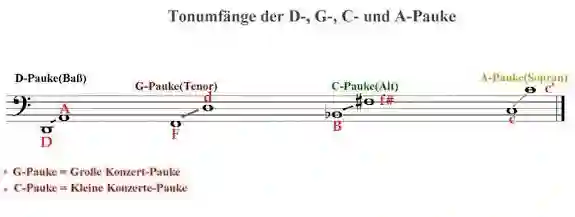Notation and sound generation » Timpani » Philipp Dangas
Notation and sound generation of the Timpani
The sound of the timpani is basically only produced by striking the skin with one or two mallets. The best sound effect is achieved when the so-called impact spot, i.e. the point of impact on the skin, is about a hand's breadth from the edge. If the hitting spot is moved closer to the middle, the sound becomes dull and higher at the same time. In the process, overtones that do not harmonize with each other are generated, which makes it difficult to recognize the exact height of the fundamental tone (especially with short beats).
The strong aftertaste of the timpani, especially in fortisimo [ff], makes it possible to distinguish the pitch of the individual notes only if the player uses hard flannel mallets. In a slow tempo, the distinction is quite possible (at the same volume). The aftertaste is also the most important obstacle to the execution of a rapid succession of single-articulated tones of different pitches. If the timpani is retuned during the duration of the aftertaste, the sounding precise tone is transformed into a glissando . In fast tone sequences, each time the pitch changes, you have to switch to a different timpani. This applies equally to the execution of the roll.
Today, without exception, the timpani are notated according to their actual sound using the bass clef. While in the scores of Johann Sebastian Bach and his contemporaries the timpani parts were only marked with the inscription "Timpani" or "Timpani", in the time of the classics the indication of the tuning of the two timpani was added to this indication, but they were still notated in C. This custom has been abandoned since Ludwig van Beethoven, who continued to use 2 timpani but used them at different intervals than before.
Download size: 97.2 kilobytes
Table summary of playing techniques on the Timpani
The following table shows the playing techniques and playing effects on the timpani shown. The playing techniques that are not suitable are also briefly mentioned.

The pitch range of a timpani in large scale
Internal search function
| Name | Value | Delete |
|---|